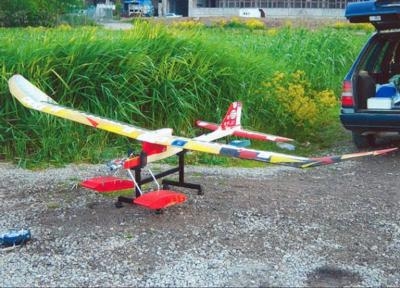Aviation Is Full Of Records, And Some Of Those Records Are About Model Airplanes
This story about a flight that occurred 10 years ago gives us a view of aviation from the vantage point of aircraft modeling. Remember, successful model aircraft were flying before the Wright Brothers’ first manned flight. Model aviation was there in the beginning, and it’s still going strong.

Ten years ago on June 17, 2006 Thomas Mardna set a world record for aeromodelling that still stands today; it was a 69 mile out-and-return flight with a piston-motor seaplane, flying along the banks of Lake Maardu in Estonia.
For Thomas Mardna the weather was perfect that day and he planned for an early, pre-dawn start. Together with co-pilot Juri Laidna the pair were aiming to set a world record out-and-return flight with a model Mardna had designed and built himself. Mardna was well-known in Estonia and the international aeromodelling scene and also an early member of the Estonian Aerosports Federation.
For the record attempt he had designed and built a special radio-controlled piston-motor seaplane. Controlled with throttle, rudder and elevator the FAI 3 Open Seaplane had a wingspan of about 11 feet and a fuselage length of 6.5 feet. The engine type was O.S. FS-52S.
On their chosen day the team of two pilots and three official observers met on the banks of Lake Maardu in northern Estonia at 4am. There, the model was assembled and checked. Empty of fuel it weighed 6.5 pounds, and with fuel it weighed 10.6 pounds.
Floating the model on the still waters of the lake the pair tested its flotation. Then, using a GPS they noted their coordinates. It was a still mid-summer’s morning, with an air temperature of 48F, a clear sky, and still wind.
Engine testing followed, and then at exactly 4:57am the record flight got underway. Mardna launched the model onto the water and prepared for flight. Within five seconds the seaplane model had completed its take-off run and was in the air, soaring gracefully into the sky.
After tagging the official start gate the model set off on course, flying at an altitude of between 500 and 600 feet AGL. The pilots and official observers followed in two cars, chasing the plane as it travelled at about 43 miles per hour. Automatic stabilization in model radio controlled aircraft was not common in 2006, and this airplane had to be hand controlled for the entire flight.
The turning point was reached at 6am, but they said there was no stopping for coffee. They flew at about 300 feet past the turning point, reversed course, and the pilots switched. It was now Juri Laidna’s turn to take the controls.
Now heading back into wind the cruising speed dropped to a about 16 miles per hour, but after increasing engine RPM to 6,500RPM that increased to about 25 miles per hour flying at about 500 feet AGL and still with good visibility they made it back to their start point at 7:27am. There, the motor was stopped and the model glided down through the air for two minutes until it landed softly in high grass on the edge of the lake, some 100 feet past where it had started from.
The flight had lasted 2-hours, 31-minutes and 31 seconds, and covered 111.01km. The distance was calculated using official FAI software, and the record still stands today.
Thomas Mardna passed away in 2013 at age 80, and is remembered in his country for his model airplane acumen.
(Image provided with press release)
 ANN's Daily Aero-Term (05.29.25): Terminal Radar Service Area
ANN's Daily Aero-Term (05.29.25): Terminal Radar Service Area ANN's Daily Aero-Term (05.30.25): Very High Frequency (VHF)
ANN's Daily Aero-Term (05.30.25): Very High Frequency (VHF) Aero-News: Quote of the Day (05.30.25)
Aero-News: Quote of the Day (05.30.25) Airborne 05.23.25: Global 8000, Qatar B747 Accepted, Aviation Merit Badge
Airborne 05.23.25: Global 8000, Qatar B747 Accepted, Aviation Merit Badge ANN's Daily Aero-Linx (05.30.25)
ANN's Daily Aero-Linx (05.30.25)



